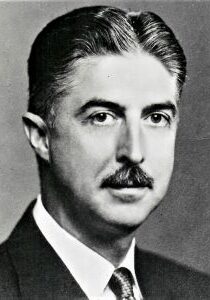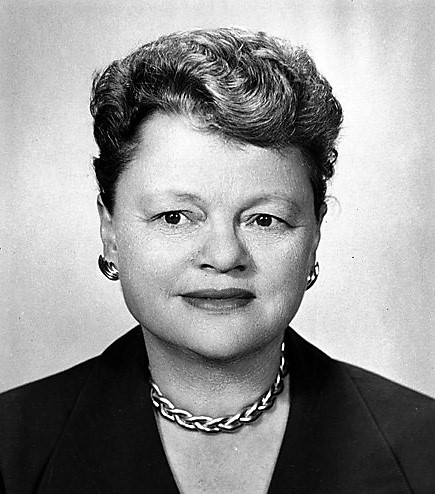People
Notable People
Henry and Emery May Norweb - Diplomat
9511 Lake Shore Boulevard

R. Henry Norweb was a career foreign service officer who held posts around the world. As a globe-trotting career diplomat, coin collector, expert in international radio, and retired U. S. ambassador, Henry Norweb, along with his wife, Emery May, were eyewitnesses to some of the 20th century’s most stirring events.
They saw the first American troops march through Paris after World War I. They experienced four revolutions in Chile in as many months. They witnessed the Japanese government deleting all reports of American aid during the 1923 Yokohama earthquake.
Raymond Henry Norweb was born on May 31, 1895, in Nottingham, England. At age 18, his family moved to Elyria, Ohio, after settling first in Illinois. Henry received his B.A. degree from Harvard in 1916. He took a civil service exam in 1916 and in 1917 went to Paris in the middle of World War I as the second secretary to William G. Sharp, ambassador to France.

Emery May Holden, the gutsy and determined daughter of Albert and Katherine Holden, was born on November 30, 1896, in Salt Lake City, Utah. She had just graduated from Westover School in Middlebury, Connecticut, when at 21 years old, she went to London as World War I began. Emery May then volunteered in Paris, driving an ambulance and caring for the wounded in French hospitals. In Paris, she met Henry Norweb and was immediately taken with the charming and well-mannered young Englishman. Emery May and Henry married in Paris in 1917.
The Norweb’s diplomatic career following the war included postings to Japan as secretary of the embassy in 1922, the Netherlands as secretary of the embassy, and chargés d’affaires in 1925. His first post to Latin America was in Chile in 1929. After serving as the counselor to the Pan American conference in 1933, he became a counselor for the American embassy in Mexico City in 1934.
In April 1936, President Franklin D. Roosevelt nominated the rising young diplomat minister to Bolivia. Less than a year later, he sent him to the Dominican Republic.
Mr. Norweb, an expert on South American affairs, was named counselor to the American delegation to the International Conference of American States in Montevideo, Uruguay, in 1933. He was a special advisor at the Inter-American Conference for the Maintenance of Peace in Buenos Aires in 1936.
On January 12, 1940, he went to Lima, Peru, as U. S. ambassador. Then at age 45, he was one of the country’s youngest ambassadors.
When the United States entered World War II, Mr. Norweb was sent to Portugal to negotiate the use of airbases.
In 1943, Roosevelt named Mr. Norweb to head the American legation in Lisbon, an important post because Lisbon was one of the largest neutral capitals in Europe. The legation was raised to embassy status in 1944. Portugal was the center of much diplomatic maneuvering and was considered a country to which only the most astute diplomat should be assigned. Norweb headed the negotiations for establishing the United States airbase in the Azores in time for the Azores to play a substantial role in the Far Eastern Campaign.
His next post was as the ambassador to Panama in 1945. Then, four months later, President Harry Truman made him the ambassador to Cuba.
After thirty-one years of diplomatic service abroad, Henry and Emery May retired in 1948 to Katewood, the Bratenahl home they acquired in 1948 and maintained during their period of diplomatic service abroad. Norweb was appointed to serve the remaining term of William Hallaran, who resigned from Bratenahl Village Council in 1960. Norweb served ten years until he resigned in 1969.
With the return of the Norwebs to Bratenahl, Emery May, who as a child bounced tennis balls off fine old paintings in her grandparent’s home, became an active member of the Cleveland Art Museum's accessions committee. In 1949, she joined the museum's board of trustees. In 1962, she became the first woman president of the Cleveland Art Museum, one of two women holding such a position in the United States.
In 1966, Mr. Norweb was appointed to the U.S. Assay Commission by President Lyndon Johnson to count, weigh and assay American coins. He soon became a coin collector.
Henry Norweb and Emery May pursued their interest in coin collecting as a team. Emery May began collecting coins as a schoolgirl when given an American colonial coin from her father. She joined the American Numismatic Association in 1914, continuing her membership for over seventy years. Emery May and Henry served together as members of the American Numismatic Society’s governing council. Henry began his first term in 1960, and Emery became the first woman member of the council when she took office in 1969. They both served until 1978.
Mr. Norweb also collected 18th-century soft-paste porcelain, which he gave to the Cleveland Museum of Art in 1961, along with a collection of French paperweights.
After more than fifty years of coin collecting, they had the most extensive American collection of English coins and specialized in American colonial, Canadian, and South American coins. Emery May was a fellow of the Royal Numismatic Society in London and of the Smithsonian.
The family sold the collection in 1987 and 1988, bringing more than $20 million. The most valuable coin was a $20 British Columbian gold coin minted in 1862. It was purchased for $143,000. The collection was sold because "It was time for these coins to be enjoyed by collectors again.
They made numerous gifts of rare coins to American numismatic institutions through the years. For example, a 52-piece collection of U.S. colonial coins was donated to the American Numismatic Society in 1969.
A 1913 Liberty head nickel was given to the Smithsonian Institution to recognize her husband's thirty-two years in the diplomatic service. However, she turned down an offer of $300,000 for the nickel, illegally struck at the Philadelphia Mint.
Emery May became blind in her 70’s, which interfered with her enjoyment of gardening, embroidery, and painting. However, she quickly learned to read Braille and worked with her coins through touch.
Henry Norweb was a historical society trustee from 1949 to 1976. He served as president of the John Huntington Fund for Education, vice president of the Cleveland Council on World Affairs, and trustee of the Kenyon College.
Social clubs included the Chagrin Valley Hunt Club, Kirtland Country Club, and the Union Club. In addition, he loved to fish and took many trips to Colorado with his two sons.
Henry Norweb died of cancer on October 1, 1983, at age 89. Emery May died just five months later, on March 27, 1984, at 88. Both are buried in Lake View Cemetery.
Raymond and Emery May had three children: Raymond Henry Jr., who was born in a Paris cellar during an air raid on August 19, 1918, Jeanne Katherine (Mother Mary Joseph), born on April 18, 1920, who lived at Loch Hame with her great uncle, Guerdon Holden, while her father and mother traveled the world on diplomatic assignments; and Albert Holden, named for his grandfather, born on November 20, 1921.
